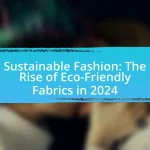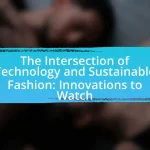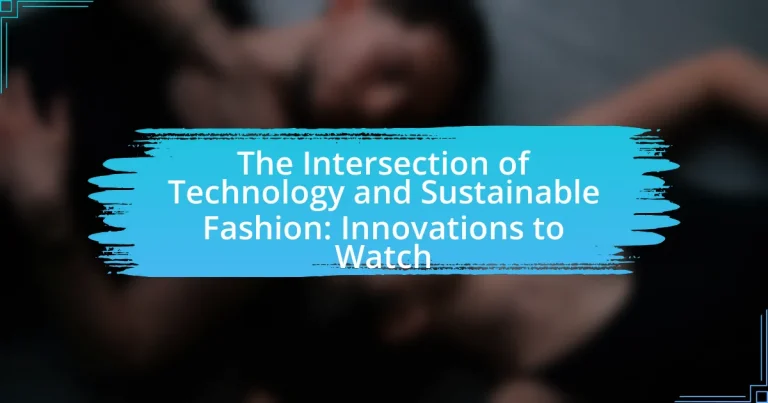The article explores the intersection of technology and sustainable fashion, highlighting how innovations such as 3D printing, blockchain, and artificial intelligence are transforming the industry. It discusses the role of these technologies in reducing waste, enhancing supply chain transparency, and promoting eco-friendly materials, ultimately leading to a lower carbon footprint for fashion brands. Key advancements in materials science, including bio-based and recycled textiles, are also examined, along with the importance of sustainable practices in addressing environmental challenges and social issues within the fashion sector. The article concludes by outlining future trends and innovations that will shape the sustainable fashion landscape.
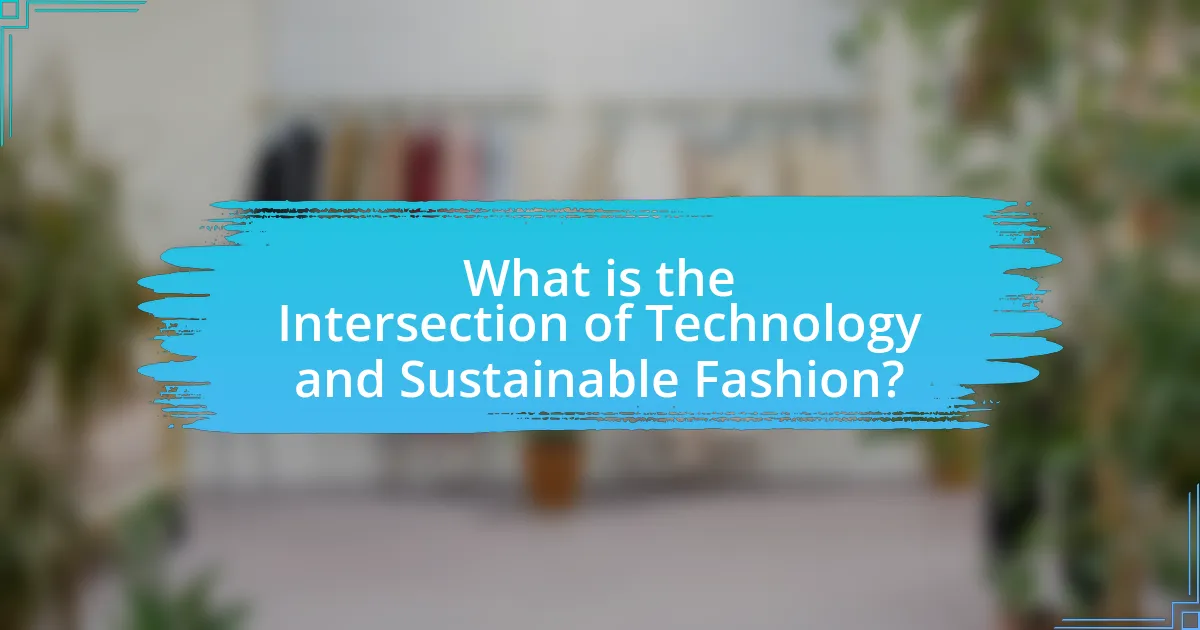
What is the Intersection of Technology and Sustainable Fashion?
The intersection of technology and sustainable fashion involves the integration of innovative technologies to enhance environmental sustainability in the fashion industry. Technologies such as 3D printing, blockchain, and artificial intelligence are being utilized to reduce waste, improve supply chain transparency, and create eco-friendly materials. For instance, 3D printing allows for on-demand production, minimizing overproduction and waste, while blockchain technology provides traceability of materials, ensuring ethical sourcing. According to a report by McKinsey & Company, the adoption of these technologies can significantly lower the carbon footprint of fashion brands, making them more sustainable.
How does technology influence sustainable fashion practices?
Technology significantly influences sustainable fashion practices by enabling more efficient production processes, reducing waste, and promoting transparency in supply chains. Innovations such as 3D printing allow for on-demand manufacturing, which minimizes overproduction and excess inventory. Additionally, blockchain technology enhances traceability, allowing consumers to verify the sustainability of materials and ethical practices behind their garments. According to a report by McKinsey & Company, the integration of digital technologies in fashion can lead to a 30% reduction in resource consumption, highlighting the potential for technology to drive sustainability in the industry.
What are the key technologies driving sustainable fashion?
Key technologies driving sustainable fashion include digital textile printing, blockchain, and innovative materials such as bio-fabricated textiles. Digital textile printing reduces waste by allowing for on-demand production, minimizing excess inventory and resource use. Blockchain enhances transparency in supply chains, enabling consumers to verify the sustainability of their garments. Innovative materials, like those derived from recycled plastics or organic sources, significantly lower the environmental impact of clothing production. For instance, the use of recycled polyester can reduce energy consumption by up to 60% compared to virgin polyester production.
How do these technologies reduce environmental impact?
Technologies in sustainable fashion reduce environmental impact by optimizing resource use and minimizing waste. For instance, innovations such as 3D printing and digital textile printing significantly decrease fabric waste by allowing precise production tailored to demand. Additionally, the use of biodegradable materials and recycling technologies helps divert textiles from landfills, reducing pollution and conserving resources. According to a report by the Ellen MacArthur Foundation, transitioning to a circular economy in fashion could reduce greenhouse gas emissions by 44% by 2030, demonstrating the effectiveness of these technologies in mitigating environmental harm.
Why is sustainable fashion important in today’s world?
Sustainable fashion is important in today’s world because it addresses environmental degradation and social inequality caused by the fast fashion industry. The fashion industry is responsible for approximately 10% of global carbon emissions and is a significant contributor to water pollution and waste, with an estimated 92 million tons of textile waste generated annually. By adopting sustainable practices, such as using eco-friendly materials and ethical labor practices, the industry can reduce its ecological footprint and promote social responsibility. This shift is crucial as consumers increasingly demand transparency and sustainability, influencing brands to innovate and adopt more responsible practices.
What are the environmental challenges faced by the fashion industry?
The fashion industry faces significant environmental challenges, including excessive water consumption, pollution from dyes and chemicals, and textile waste. For instance, the production of a single cotton t-shirt can require up to 2,700 liters of water, highlighting the industry’s strain on water resources. Additionally, the dyeing process contributes to water pollution, with an estimated 20% of global industrial water pollution stemming from textile treatment and dyeing. Furthermore, the fashion industry generates approximately 92 million tons of waste annually, much of which ends up in landfills, exacerbating environmental degradation. These challenges underscore the urgent need for sustainable practices within the industry.
How does sustainable fashion address social issues?
Sustainable fashion addresses social issues by promoting fair labor practices and supporting marginalized communities. This approach often includes ensuring safe working conditions, fair wages, and the empowerment of workers, particularly in developing countries where exploitation is prevalent. For instance, brands that adopt sustainable practices frequently collaborate with organizations that advocate for workers’ rights, thereby improving the livelihoods of those in the fashion supply chain. Additionally, sustainable fashion often emphasizes transparency, allowing consumers to make informed choices that support ethical production methods, which can lead to broader social change.

What Innovations are Emerging at the Intersection of Technology and Sustainable Fashion?
Innovations emerging at the intersection of technology and sustainable fashion include the use of artificial intelligence for supply chain optimization, 3D printing for reducing waste, and blockchain for transparency in sourcing. Artificial intelligence enables brands to predict trends and manage inventory more efficiently, thereby minimizing overproduction, which is a significant issue in the fashion industry. For instance, companies like Stitch Fix utilize AI algorithms to tailor recommendations, reducing unsold stock.
3D printing technology allows designers to create garments on-demand, significantly cutting down fabric waste associated with traditional manufacturing processes. Brands such as Adidas have begun implementing 3D printing to produce shoes with minimal material waste.
Blockchain technology enhances transparency by providing a secure and immutable record of a product’s journey from raw material to consumer. This innovation helps consumers make informed choices about the sustainability of their purchases. For example, the Provenance platform enables brands to share their supply chain information directly with consumers, fostering trust and accountability.
These innovations collectively contribute to a more sustainable fashion ecosystem by addressing key challenges such as waste reduction, resource efficiency, and ethical sourcing.
What role does artificial intelligence play in sustainable fashion?
Artificial intelligence plays a crucial role in sustainable fashion by optimizing supply chains, reducing waste, and enhancing design processes. AI algorithms analyze consumer data to predict trends, enabling brands to produce only what is needed, thereby minimizing overproduction and excess inventory. For instance, companies like H&M and Zara utilize AI for demand forecasting, which has been shown to reduce waste by up to 30%. Additionally, AI-driven tools assist in material selection and recycling processes, promoting the use of sustainable materials and improving the circularity of fashion products. This integration of AI not only supports environmental goals but also enhances operational efficiency within the fashion industry.
How can AI improve supply chain transparency?
AI can improve supply chain transparency by enabling real-time data tracking and analysis throughout the supply chain process. By utilizing machine learning algorithms and IoT devices, companies can monitor inventory levels, shipment statuses, and supplier performance in real time. This capability allows for enhanced visibility into each stage of the supply chain, reducing information asymmetry and fostering accountability among stakeholders. For instance, a study by McKinsey & Company highlights that companies leveraging AI for supply chain management can achieve up to a 20% reduction in operational costs and a 50% improvement in forecasting accuracy, thereby reinforcing the importance of transparency in driving efficiency and sustainability in the fashion industry.
What are the applications of AI in consumer behavior analysis?
AI is applied in consumer behavior analysis through predictive analytics, personalized marketing, and sentiment analysis. Predictive analytics utilizes algorithms to forecast consumer purchasing patterns based on historical data, enabling brands to optimize inventory and marketing strategies. Personalized marketing leverages AI to tailor recommendations and advertisements to individual preferences, enhancing customer engagement and conversion rates. Sentiment analysis employs natural language processing to assess consumer opinions from social media and reviews, providing insights into brand perception and consumer satisfaction. These applications collectively enhance understanding of consumer behavior, driving more effective marketing strategies in the sustainable fashion sector.
How are materials science advancements contributing to sustainable fashion?
Materials science advancements are significantly contributing to sustainable fashion by enabling the development of eco-friendly materials and innovative production processes. For instance, the creation of biodegradable fabrics, such as those derived from organic cotton or recycled polyester, reduces environmental impact by minimizing waste and pollution. Additionally, advancements in textile recycling technologies allow for the efficient repurposing of old garments, thus decreasing the demand for virgin materials. Research indicates that using recycled fibers can reduce water consumption by up to 90% compared to conventional fabric production. These innovations not only enhance the sustainability of fashion but also align with consumer demand for environmentally responsible products.
What are bio-based and recycled materials being used in fashion?
Bio-based and recycled materials used in fashion include organic cotton, Tencel, and recycled polyester. Organic cotton is cultivated without synthetic pesticides, reducing environmental impact, while Tencel, made from sustainably sourced wood pulp, is biodegradable and produced in a closed-loop process that minimizes waste. Recycled polyester, derived from post-consumer plastic bottles, diverts waste from landfills and reduces reliance on virgin petroleum-based materials. According to the Textile Exchange’s 2021 report, the use of recycled materials in the fashion industry has increased significantly, highlighting a growing trend towards sustainability.
How do these materials compare to traditional fabrics?
These materials, often derived from sustainable sources or innovative processes, typically outperform traditional fabrics in terms of environmental impact and functionality. For instance, materials like Tencel and recycled polyester have a lower carbon footprint and require less water during production compared to conventional cotton and polyester. Research indicates that Tencel production uses up to 95% less water than cotton, highlighting its sustainability advantage. Additionally, many of these innovative fabrics offer enhanced properties such as moisture-wicking, breathability, and durability, which are not always present in traditional textiles.
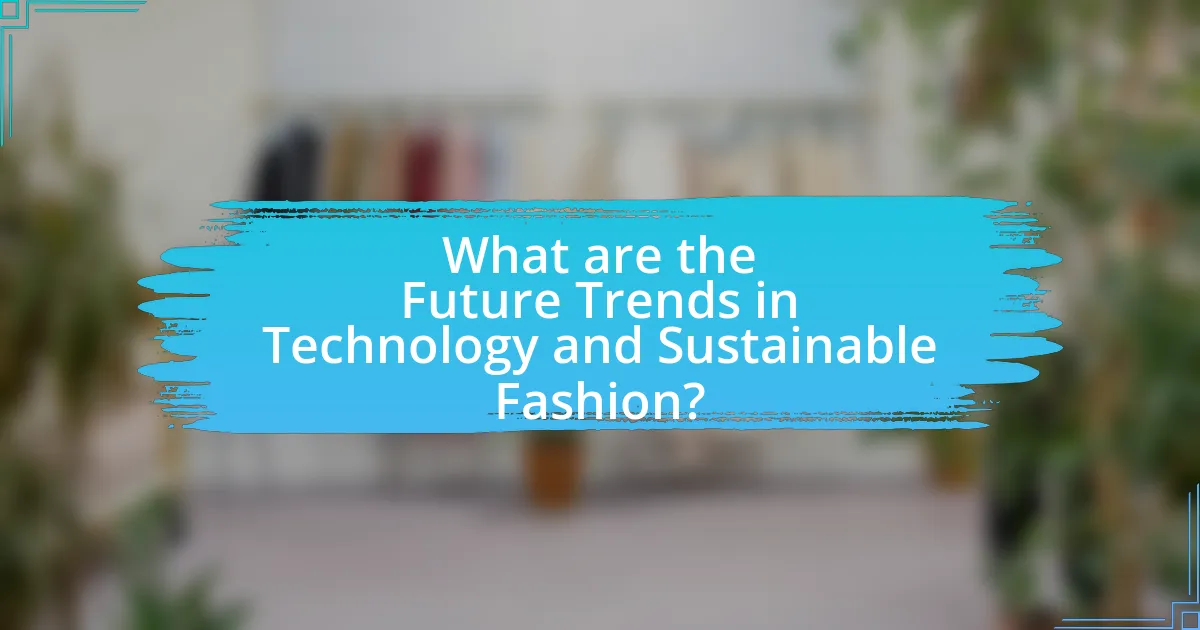
What are the Future Trends in Technology and Sustainable Fashion?
Future trends in technology and sustainable fashion include the integration of artificial intelligence, blockchain, and circular economy practices. Artificial intelligence is being utilized for predictive analytics in consumer behavior, enabling brands to create more sustainable production processes by reducing waste. Blockchain technology enhances transparency in supply chains, allowing consumers to verify the sustainability of materials used in their clothing. Additionally, the circular economy is gaining traction, with brands adopting practices such as recycling and upcycling to minimize environmental impact. According to a report by McKinsey & Company, the sustainable fashion market is projected to grow significantly, driven by consumer demand for eco-friendly products and innovative technologies that support sustainability.
What innovations should we watch for in the coming years?
In the coming years, we should watch for innovations in sustainable materials, such as bio-fabricated textiles and recycled fibers. These advancements are driven by the need to reduce environmental impact and resource consumption in the fashion industry. For instance, companies like Bolt Threads are developing mycelium-based leather alternatives, which significantly lower carbon emissions compared to traditional leather production. Additionally, the use of blockchain technology for supply chain transparency is expected to grow, enabling consumers to verify the sustainability of their clothing. This trend is supported by a report from McKinsey & Company, which highlights that 67% of consumers are willing to pay more for sustainable products, indicating a strong market demand for these innovations.
How will 3D printing change the fashion landscape?
3D printing will revolutionize the fashion landscape by enabling on-demand production, reducing waste, and allowing for unprecedented customization. This technology allows designers to create complex patterns and structures that traditional manufacturing cannot achieve, leading to innovative designs and materials. According to a report by the World Economic Forum, 3D printing can reduce material waste by up to 90% compared to conventional methods, significantly contributing to sustainability in fashion. Additionally, brands like Adidas and Nike are already utilizing 3D printing to produce customized footwear, demonstrating the practical application and market potential of this technology in transforming how fashion is designed and produced.
What potential does blockchain hold for sustainable fashion?
Blockchain holds significant potential for sustainable fashion by enhancing transparency and traceability in the supply chain. This technology allows brands to record every transaction and movement of materials on an immutable ledger, enabling consumers to verify the origins and sustainability practices of their garments. For instance, companies like Provenance and Everledger utilize blockchain to provide detailed information about the sourcing and production processes of fashion items, which can lead to more informed purchasing decisions. Additionally, a report by the World Economic Forum highlights that blockchain can reduce waste and promote circular economy practices by facilitating the resale and recycling of clothing through verified ownership records.
How can consumers engage with technology in sustainable fashion?
Consumers can engage with technology in sustainable fashion by utilizing apps and platforms that promote eco-friendly brands and practices. These technologies enable consumers to make informed purchasing decisions by providing information on the sustainability of materials, production processes, and brand ethics. For instance, apps like Good On You rate fashion brands based on their environmental impact and labor practices, allowing consumers to choose more sustainable options. Additionally, virtual fitting rooms and augmented reality tools help reduce returns and waste by allowing consumers to visualize how clothing will fit before purchasing. This engagement not only supports sustainable brands but also encourages a shift towards more responsible consumption patterns in the fashion industry.
What are the best practices for supporting sustainable brands?
To support sustainable brands effectively, consumers should prioritize purchasing from companies that demonstrate transparency in their supply chains and use eco-friendly materials. Research indicates that brands like Patagonia and Eileen Fisher have successfully implemented sustainable practices, such as using recycled materials and ensuring fair labor conditions, which resonate with environmentally conscious consumers. Additionally, engaging with brands through social media and providing feedback can help promote their sustainable initiatives, as seen in the growing community around sustainable fashion influencers who advocate for responsible consumption.
How can technology enhance consumer awareness and education?
Technology enhances consumer awareness and education by providing accessible information and interactive platforms that facilitate learning about sustainable practices. For instance, mobile applications and websites can offer detailed product information, including sourcing, manufacturing processes, and environmental impact, empowering consumers to make informed choices. Research indicates that 70% of consumers are more likely to purchase from brands that provide transparency about their sustainability efforts, as highlighted in a 2021 study by Nielsen. Additionally, social media platforms enable brands to engage directly with consumers, sharing educational content and fostering discussions around sustainable fashion, which further increases awareness and understanding.
What practical steps can be taken to embrace technology in sustainable fashion?
To embrace technology in sustainable fashion, brands can implement digital tools for supply chain transparency, such as blockchain technology, which allows for tracking the origin and journey of materials. This step enhances accountability and reduces waste by ensuring that resources are sourced responsibly. Additionally, utilizing 3D printing technology can minimize fabric waste by producing garments on demand, thus aligning production with actual consumer demand. Research indicates that 3D printing can reduce material waste by up to 90% compared to traditional manufacturing methods. Furthermore, integrating artificial intelligence in inventory management can optimize stock levels, reducing overproduction and excess inventory, which are significant contributors to environmental degradation in the fashion industry.







